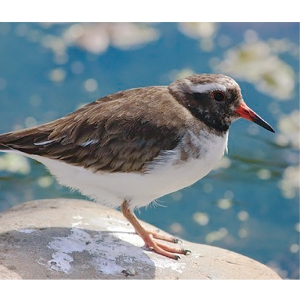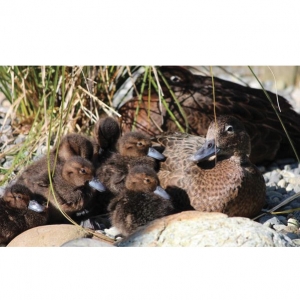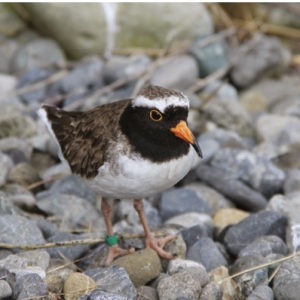Displaying items by tag: Mount Bruce
Whio freedom
A great day out at Ruatiti Domain on the Manganui a te Ao River where we released 12 captive reared Whio, 7 females and 5 males. We had a good turn out with school children, Iwi, Horizon councillors, land owners, two Orana Park staff who released one of the Whio they had raised, a film crew and Doc staff, interested visitors and Anne and me. The Whio were reared by staff at Peacock Springs, Orana Park and Mt Bruce.
Peter Russell.
Eds note: The Manganui a te Ao River starts on the western flank of Mt Ruapehu and flows westward through forest and steep hill country north-west of Raetihi, Waimarino County, Taihape and then joins the Wanganui River. The name means - stream; great; of; the; world.
Free flight aviary at Pukaha Mt Bruce
At Pukaha Mt Bruce staff have been delighted with the way the birds have settled into their new home in the free flight aviary. The whio and pateke are loving their new areas and are not difficult to spot. The whio are in an ‘internal aviary’ with a new river run while the other birds are all together in the bigger aviary space. Both the pateke and whio are breeding pairs.
The korimako seem to spend all day singing and while the kaka and kereru took a little while to settle in, they have been busy exploring their new space and are almost oblivious to the visitors who walk through the aviary.
If you are lucky enough to be at Pukaha at the free flight aviary at around 4pm there could be a ranger talk at the “Final Flight” area. It tells the story of the restoration project for the Pukaha forest and how captive breeding can help to protect and grow our endangered species
Shore Plover breeding success at Pukaha Mount Bruce
The mission to save more than one endangered bird species has been enriched by last year’s successful breeding programmes at Pukaha Mount Bruce.
The Shore Plover programme saw over 10 birds transported from Pukaha Mt Bruce National Wildlife Centre to Motutapu Island in the Hauraki Gulf and Portland Island off the Mahia peninsula.
The shore plover is in a perilous position with fewer than 200 left in the wild and a history of conservation efforts being hampered by rat infestations. Shore plover were first spotted by observers on Captain Cook’s second voyage to New Zealand.
The shore plover is the most endangered bird reared and cared for at the centre. It is very susceptible to mammalian predators, even one rat can cause enormous damage.
Past Department of Conservation attempts to establish shore plover on Mana and Portland Islands were undone by what was thought to be a single rat in both cases.
The breeding and hatching of over 10 chicks at Pukaha had been a real triumph for the staff and wider conservation efforts.
In another success for the breeding programme, there were also over 10 pateke (brown teal) bred and hatched at the centre in the last breeding season.
The endangered ducks have a wild population of between 2,000 and 2,500 making them New Zealand’s most rare mainland waterfowl.
As well as great results in the Shore Plover and Pateke recovery programmes, the Whio (Blueduck) also produced more than one clutch of ducklings.
Pukaha’s new free flight aviary that opened in May 2016 enabled the breeding pair of Whio that call it home, to lay eggs which were then artificially incubated and hand-reared. Those ducks were sent to Turangi where they spent time in a purpose-built environment to prepare them for release to the wild.
The second clutch of eggs is allowed to stay with the parents and be raised naturally.
The theory is that by letting the parents raise them, the ducklings will be better parents when it is their time to breed.
By Illy McLean and Laura Hutchinson
New hatchings at Pukaha Mount Bruce
September 2017: Pukaha Mt Bruce
Since staff at Pukaha last caught up, the Pateke pair now have six ducklings in their care. The Whio, that live in their free flight aviary have also been sitting on a clutch of five eggs.
Also the first monitored wild kiwi chicks were safely hatched in the reserve. Staff said it was great to see the first conservation breeding of the season had taken place in the new free flight aviary. It is a super sign that the wildlife love this new space as much as the visitors who go to see the new young ones at Pukaha.
Free flight aviary popular at Pukaha Mt Bruce
At Pukaha Mt Bruce staff have been delighted with the way the birds have settled into their new home in the free flight aviary. The whio and pateke are loving their new areas and are not difficult
to spot. The whio are in an ‘internal aviary’ with a new river run while the other birds are all together in the bigger aviary space. Both the pateke and whio are breeding pairs.
The korimako seem to spend all day singing and while the kaka and kereru took a little while to settle in, they are now happy and busy in their new space and are almost oblivious to the visitors
who walk through the aviary.
If you are lucky enough to be at Pukaha at the free flight aviary at around 4pm there could be a ranger talk at the “Final Flight” area. It tells the story of the restoration project for the Pukaha forest and how captive breeding can help to protect and grow our endangered species.
Shore Plover breeding success at Pukaha Mount Bruce
The mission to save more than one endangered bird species has been enriched by last year’s successful breeding programmes at Pukaha Mount Bruce.
The Shore Plover programme saw over 10 birds transported from Pukaha Mt Bruce National Wildlife Centre to Motutapu Island in the Hauraki Gulf and Waikawa Island off the Mahia peninsula (see photo).
The shore plover is in a perilous position with fewer than 200 left in the wild and a history of conservation efforts being hampered by rat infestations. Shore plover were first spotted by observers on Captain Cook’s second voyage to New Zealand.
The shore plover is the most endangered bird reared and cared for at the Pukaha centre. It is very susceptible to mammalian predators; even one rat can cause enormous damage.
Past Department of Conservation attempts to establish shore plover on Mana and Portland Islands were undone by what was thought to be a single rat in both cases.
The breeding and hatching of over 10 chicks at Pukaha had been a real triumph for the staff and wider conservation efforts.
In another success for the breeding programme, over 10 pateke (brown teal) were bred and hatched at the centre in the last breeding season.
The endangered ducks have a wild population of between 2000 and 2500 making them New Zealand’s most rare mainland waterfowl.
As well as great results in the Shore Plover and Pateke recovery programmes, the whio (Blue duck) also produced more than one clutch of ducklings.
Pukaha new free flight aviary that opened in May 2016 enabled the breeding pair of whio that call it home to lay eggs which were then artificially incubated and hand-reared. Those ducks were sent to Turangi where they spent time in a purpose-built environment to prepare them for release to the wild.
The second clutch of eggs is allowed to stay with the parents and be raised naturally. The theory is that by letting the parents raise them, the ducklings will be better parents when it is their time to breed.
Laura Hutchinson - Marketing & Communications.
Pukaha Mount Bruce
027 244 1221
www.Pukaha.org.nz




